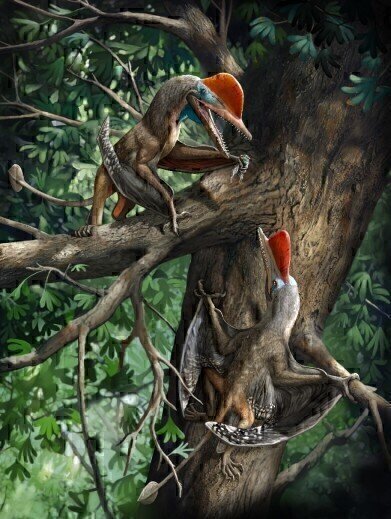-
 Life reconstruction of K. antipollicatus (Image credit: Chuang Zhao)
Life reconstruction of K. antipollicatus (Image credit: Chuang Zhao)
News & Views
Opposed Thumb Structure revealed by Jurassic Flying Reptile
Apr 25 2021
An international team of researchers from China, Brazil, UK, Denmark and Japan have described a new Jurassic pterosaur Kunpengopterus antipollicatus, as having the oldest true opposed thumb - a novel structure previously not known in pterosaurs.
Discovered in the Tiaojishan Formation of Liaoning, China, the new 160-million year old species dubbed ‘Monkeydactyl’, is a small-bodied darwinopteran pterosaur with an estimated wingspan of 85 cm. Most importantly, the specimen was preserved with an opposed pollex (“thumb”) on both hands.
The research team scanned the fossil of K. antipollicatus using micro-computed tomography (micro-CT), a technique making use of X-ray to image an object. By studying its forelimb morphology and musculature, they suggest that K. antipollicatus could have used its hand for grasping, which is likely an adaptation for arboreal life.
In order to test the arboreal interpretation, the team analysed K. antipollicatus and other pterosaurs using a set of anatomical characters related to arboreal adaptation. The results support K. antipollicatus as an arboreal species, but not the other pterosaurs from the same ecosystem. This suggests niche-partitioning among these pterosaurs and provides the first quantitative evidence that at least some darwinopteran pterosaurs were arboreal.
Fion Waisum Ma, co-author of the study and PhD researcher at the University of Birmingham, said: “The fingers of ‘Monkeydactyl’ are tiny and partly embedded in the slab. Thanks to micro-CT scanning, we could see through the rocks, create digital models and tell how the opposed thumb articulates with the other finger bones.
“This is an interesting discovery. It provides the earliest evidence of a true opposed thumb, and it is from a pterosaur - which wasn’t known for having an opposed thumb’ she added.
Xuanyu Zhou from China University of Geosciences who led the study commented: “Tiaojishan palaeoforest is home to many organisms, including three genera of darwinopteran pterosaurs. Our results show that K. antipollicatus has occupied a different niche from Darwinopterus and Wukongopterus, which has likely minimised competition among these pterosaurs.”
Rodrigo V. Pêgas from Federal University of ABC, in Sao Bernardo, Brazil, said: “Darwinopterans are a group of pterosaurs from the Jurassic of China and Europe, named after Darwin due to their unique transitional anatomy that has revealed how evolution affected the anatomy of pterosaurs throughout time.
“On top of that, a particular darwinopteran fossil has been preserved with two associated eggs, revealing clues to pterosaur reproduction. They’ve always been considered precious fossils for these reasons and it is impressive that new darwinopteran species continue to surprise us.”
Published in Current Biology.
More information online
Digital Edition
Lab Asia 31.2 April 2024
April 2024
In This Edition Chromatography Articles - Approaches to troubleshooting an SPE method for the analysis of oligonucleotides (pt i) - High-precision liquid flow processes demand full fluidic c...
View all digital editions
Events
Apr 22 2024 Marrakech, Morroco
Making Pharmaceuticals Exhibition & Conference
Apr 23 2024 Coventry, UK
Apr 23 2024 Kintex, South Korea
Apr 23 2024 Seoul, South Korea
Apr 24 2024 Jakarta, Indonesia







.jpg)









